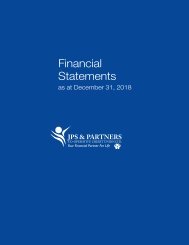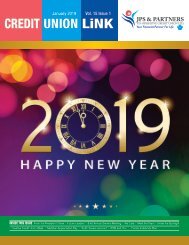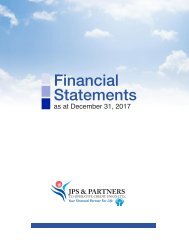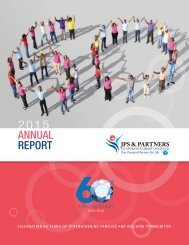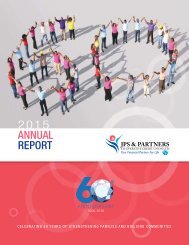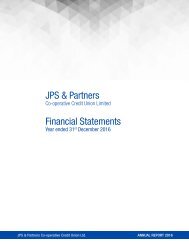JPS & Partners 2017 Annual Report
You also want an ePaper? Increase the reach of your titles
YUMPU automatically turns print PDFs into web optimized ePapers that Google loves.
Notes to the Financial Statements<br />
For the year ended 31st December <strong>2017</strong><br />
(Expressed in Jamaican Dollars unless otherwise indicated)<br />
2. Adoption of Standards, Interpretations and Amendments (Cont'd):<br />
(b) Standards and interpretations in respect of published standards that are not in effect (cont'd):<br />
IFRS 9: Financial Instruments (2014) (Effective January 2018)<br />
A finalised version of IFRS 9 which contains accounting requirements for financial instruments, replacing IAS<br />
39 Financial Instruments: Recognition and Measurement. The standard contains requirements in the following areas:<br />
Classification and measurement : Financial assets are classified by reference to the business model within which they<br />
are held and their contractual cash flow characteristics. The 2014 version of IFRS 9 introduces a 'fair value through<br />
other comprehensive income' category for certain debt instruments. Hence, financial assets are to be classified into<br />
three measurement categories: those measured at amortised cost, those to be measured subsequently at fair value<br />
through other profit and loss (FVPL) and those to be measured subsequently at fair value through other<br />
comprehensive income (FVOCI). Financial liabilities are classified in a similar manner to under IAS 39, however<br />
there are differences in the requirements applying to the measurement of an entity's own credit risk.<br />
Impairment: The 2014 version of IFRS 9 introduces an 'expected credit loss' model for the measurement of the<br />
impairment of financial assets, so it is no longer necessary for a credit event to have occurred before a credit loss is<br />
recognised.<br />
Hedge accounting : Introduces a new hedge accounting model that is designed to be more closely aligned with how<br />
entities undertake risk management activities when hedging financial and non-financial risk exposures<br />
Derecognition: The requirements for the derecognition of financial assets and liabilities are carried forward from<br />
IAS 39.<br />
Note: Depending on the chosen approach to applying IFRS 9, the transition can involve one or more than one date of<br />
initial application for different requirements.<br />
Management has determined that the standard is relevant to existing policies for its current operations, but has not<br />
yet assessed the impact on adoption.<br />
Clarifications to IFRS 15 : Revenue from Contracts with Customers (Effective January 2018)<br />
Amends IFRS 15 Revenue from Contracts with Customers to clarify three aspects of the standard (identifying<br />
performance obligations, principal versus agent considerations, and licensing) and to provide some transition relief<br />
for modified contracts and completed contracts.<br />
Amendments to IAS 40 - Investment Property Transfers of Investment Property (Effective January 2018)<br />
The amendments to IAS 40 Investment Property:<br />
-<br />
-<br />
Amends paragraph 57 to state that an entity shall transfer a property to, or from, investment property when, and<br />
only when, there is evidence of a change in use. A change of use occurs if property meets, or ceases to meet, the<br />
definition of investment property. A change in management’s intentions for the use of a property by itself does<br />
not constitute evidence of a change in use.<br />
The list of examples of evidence in paragraph 57(a) – (d) is now presented as a non-exhaustive list of examples<br />
instead of the previous exhaustive list.<br />
Pushing you Beyond All Limits!<br />
59<br />
<strong>JPS</strong> & <strong>Partners</strong> Co-operative Credit Union







